Latest news about Bitcoin and all cryptocurrencies. Your daily crypto news habit.
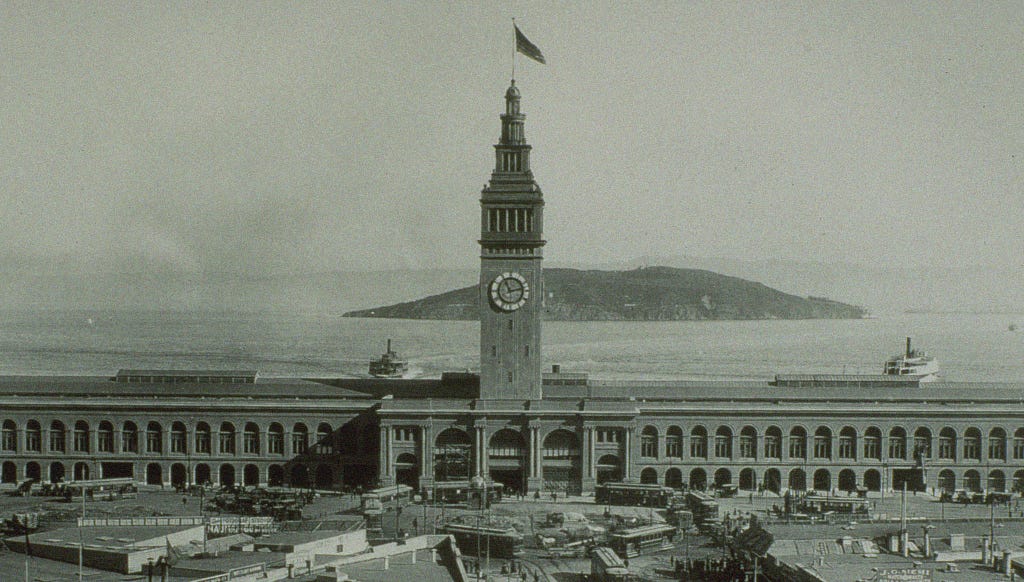 San Francisco Ferry Building from Market Street (circa 1898)“We all were sea-swallow’d, though some cast again,And by that destiny to perform an actWhereof what’s past is prologue, what to comeIn yours and my discharge.”—The Tempest, William Shakespeare
San Francisco Ferry Building from Market Street (circa 1898)“We all were sea-swallow’d, though some cast again,And by that destiny to perform an actWhereof what’s past is prologue, what to comeIn yours and my discharge.”—The Tempest, William Shakespeare
As 2017 comes to an end, it’s appropriate to reflect on changes during the past 12 months. But the passage of time is continuous, and changes are much more pronounced when aggregated over years and decades.
San Francisco was founded as a Spanish colony in 1776 — the same year the United States declared its independence from Britain. California (and San Francisco) became part the United States in 1848 as a concession of the Mexican-American war. The California Gold Rush (1848–1849) brought an economic surge to San Francisco, as industrious souls flocked to the region in search of their fortune. By the late-1800s, San Francisco was the most populous city on the West Coast.
The San Francisco Ferry Building opened in 1898 as the transit hub for the burgeoning city. The Ferry Building quickly became one of the busiest transit terminals in the world — second only to London’s Charing Cross Station. It has seen its share of history; the well-built structure survived the 7.8 magnitude earthquake in 1906 (which destroyed 80% of the city) as well as the 6.9 magnitude earthquake in 1989.
The defining characteristic of the Ferry Building is its 245-foot (75m) clock tower. It still houses its original clock made in 1898 — the largest wind-up, mechanical dial clock in the world. The clock face serves as a reminder of the passage of time and the evolution of San Francisco.
In San Francisco, the Ferry Building is the focus of every New Year’s Eve celebration. On the stroke of midnight, the venerable clock rings in the new year while basking in the celebratory glow of fireworks.
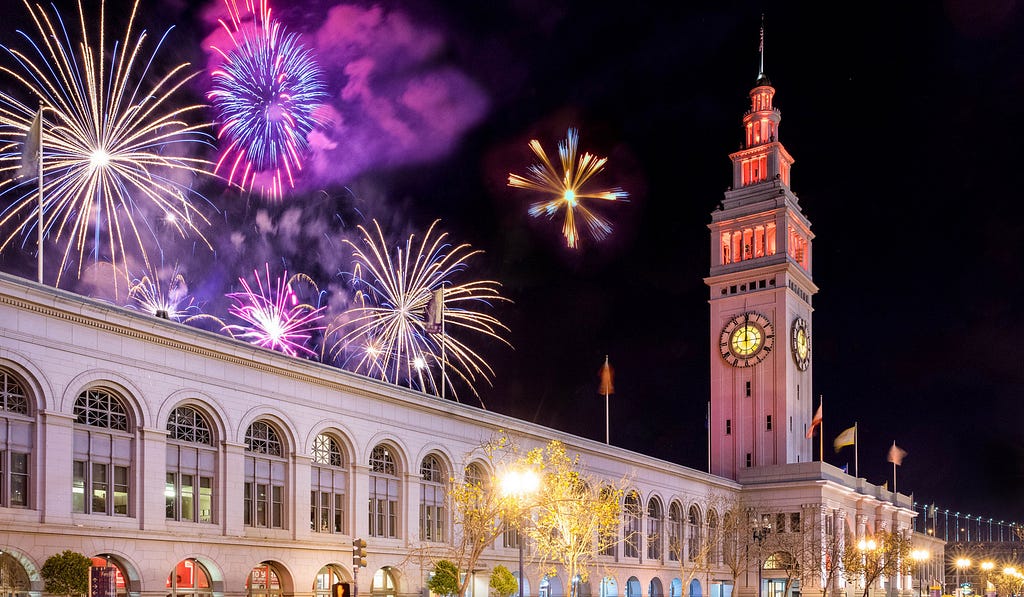 “He trod the water,Whose enmity he flung aside, and breastedThe surge most swoln that met him; his bold head‘Bove the contentious waves he kept.”
“He trod the water,Whose enmity he flung aside, and breastedThe surge most swoln that met him; his bold head‘Bove the contentious waves he kept.”
Ferries were the only mode of transportation across the San Francisco Bay until the 1930s, when both the Bay Bridge and the Golden Gate Bridge were constructed.
The Golden Gate Bridge spans the 1 mile (1.6km) strait connecting the Pacific Ocean and the San Francisco Bay. The suspension bridge was finished and opened in May 1937; this past year marked its 80th anniversary.
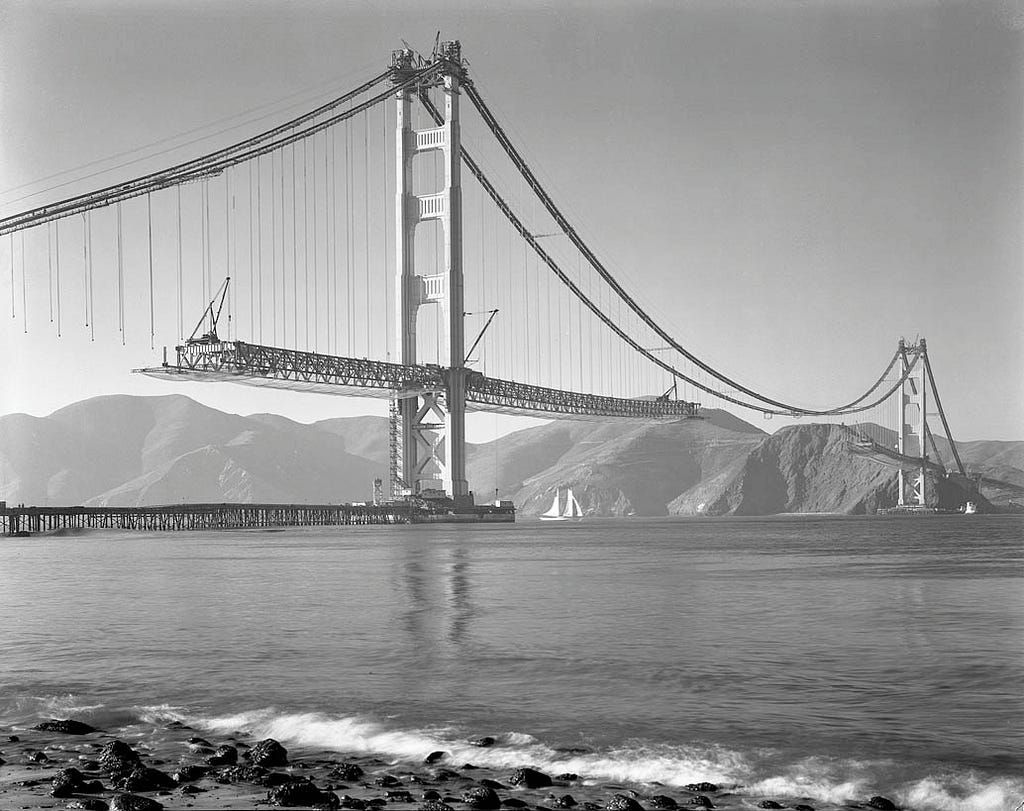 Hanging the Roadway from the Golden Gate Bridge (1937)
Hanging the Roadway from the Golden Gate Bridge (1937)
Experts doubted that a bridge could be built across the strait due to the swirling tides and frequent strong winds.
Construction began in January 1933, and the bridge was completed ahead of schedule and under budget.
At the time of its opening, it was both the longest and tallest suspension bridge in the world. It remains the tallest bridge in the United States
The Bay Bridge was built during the same timeframe as the Golden Gate Bridge. Construction began in July 1933 and completed in November 1936. The Bay Bridge western crossing connects San Francisco with Yerba Buena Island; its eastern crossing links Yerba Buena Island with the city of Oakland.
In 1989, the Loma Prieta earthquake caused a collapse on the eastern section of the Bay Bridge. This section consisted of a double-balanced cantilever bridge, five truss bridges, and 2 truss causeways. After the 1989 earthquake, the replacement of the eastern crossing of the Bay Bridge was inevitable.
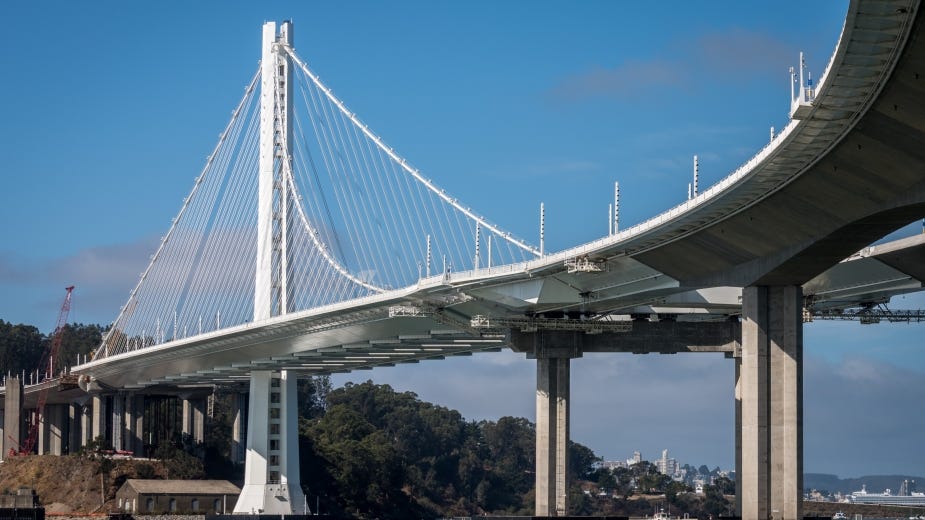 Self-Anchored Suspension Span of the Bay Bridge (2015)
Self-Anchored Suspension Span of the Bay Bridge (2015)
Construction of a new eastern section of the Bay Bridge was started in 2002 and was completed in 2013. The new eastern section includes a single-towered self-anchored suspension span.
It is far more resilient to the threat of earthquakes.
With its eastbound and westbound lanes on either side, the Bay Bridge has the widest bridge span in the world.
“I’ll deliver all;And promise you calm seas, auspicious galesAnd sail so expeditious that shall catchYour royal fleet far off.”
Motorized vehicles were already common in the 1930s, and the two bridges in San Francisco were created to carry vehicles — predominantly automobiles. Almost everyone associates the automobile with Henry Ford.
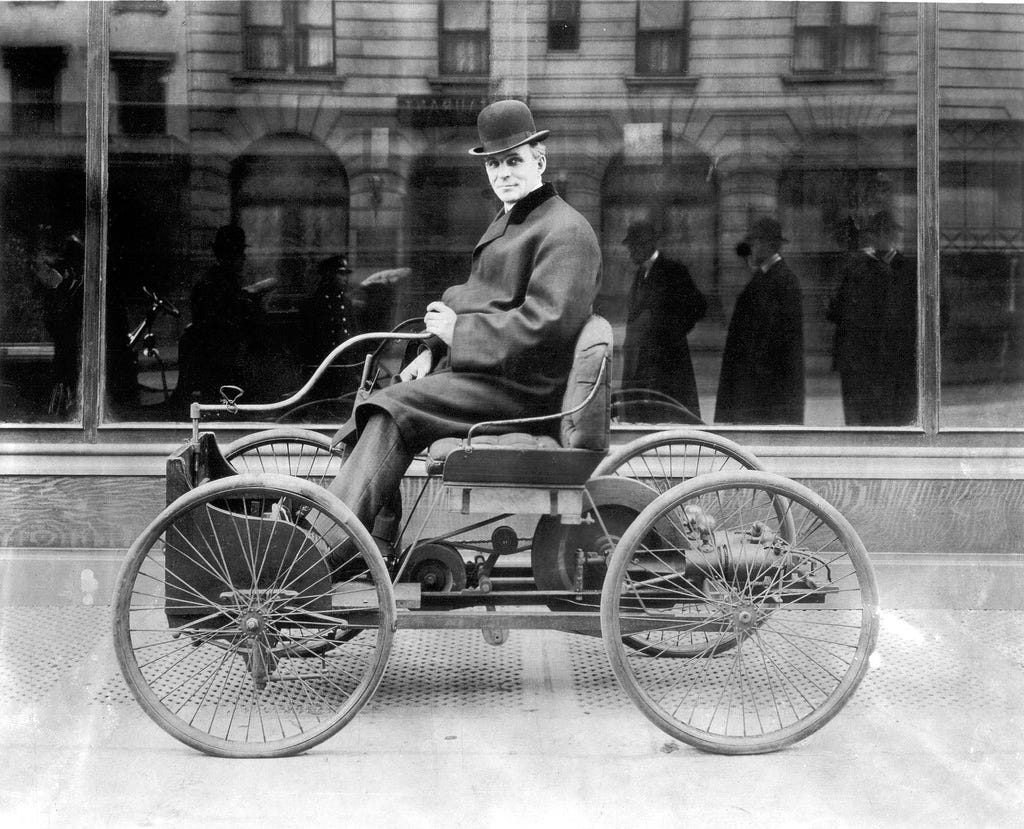 Henry Ford with his Quadricycle (1896)
Henry Ford with his Quadricycle (1896)
But Ford’s greatest contribution to the automotive industry wasn’t his first vehicle (the Quadricycle) or his Model T.
Instead, it was Ford’s innovation in manufacturing that enabled broad adoption of the automobile.
The moving assembly line for the Model T began operation in October 1913, allowing each car to be produced in 93 minutes — faster than it took paint to dry!
Over 100 years have passed since the first moving assembly line for automobiles. Every year, 100 million cars are produced in over 50 countries. The United States produced 80% of all motor vehicles in 1950, but today that percentage is around 12%. In 2016, China built 28 million vehicles — four times as many were built in the United States.
For the past century, the dominant propulsion method for automobiles has been the internal combustion engine — despite the fact that electric vehicles were among the earliest automobiles. In 1900, 28% of cars on the road in the U.S. were electric. But popularity of electric vehicles declined due to the limitations of storage batteries and the availability of cheap petroleum.
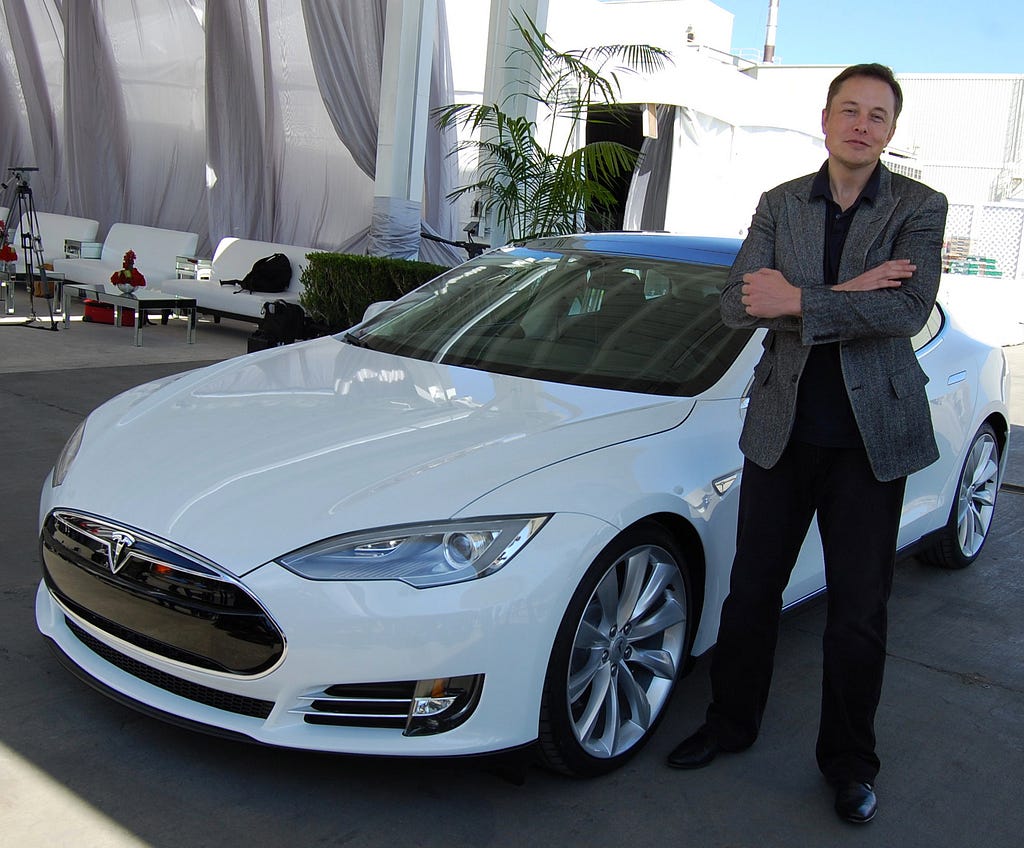 Elon Musk and the Tesla Model S (2011)
Elon Musk and the Tesla Model S (2011)
Interest in electric vehicles has revived in recent decades, primarily due to environmental concerns of burning fossil fuels.
At the forefront of the electric vehicle resurgence is Elon Musk, CEO of Tesla.
Each Tesla automobile contains thousands of small lithium-ion batteries for storing electricity. This approach has resulted in much cheaper and lighter battery cells for Tesla vehicles.
The Tesla Model S was the world’s best-selling plug-in electric car in 2015 and 2016. Tesla global vehicle sales surpassed 250,000 units in September 2017.
California is the largest plug-in car regional market in the United States. Over 46% of all plug-in electric vehicles sold in the U.S. were sold in California between December 2010 and March 2015. After 100 years of technology advances, electric vehicles are poised for broad adoption across the globe.
“Be’t to fly,To swim, to dive into the fire, to rideOn the curl’d clouds”
The development of the automobile (and accompanying infrastructure) enabled people to travel vast distances on the ground. The world became even more accessible with the invention of aircraft.
Mankind has yearned to fly for over two thousand years. The earliest flight was several hundred years BC, in the form of man-carrying kites in China. In the mid-15th century, Leonardo da Vinci studied bird flight and designed a hang glider with fixed wings and control surfaces (though it did not fly). Experiments with gliders provided the groundwork for heavier-than-air craft.
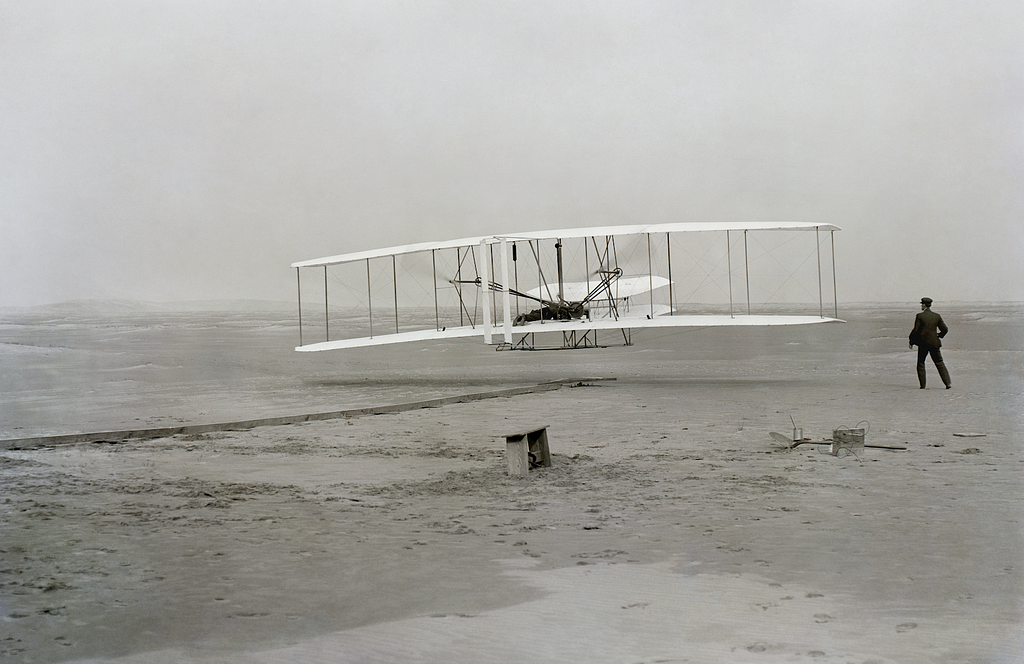 First flight of the Wright Flyer I (December 1903)
First flight of the Wright Flyer I (December 1903)
Orville and Wilber Wright began experimenting with gliders in 1900. They defined and evolved three-axis flight control: roll, pitch, and yaw.
In 1903, the brothers built the Wright Flyer I, a powered glider. Orville successfully achieved first powered flight on December 17, 1903: 120 feet (37m) at a speed of 6.8 miles per hour (10.9km/hr).
Over the past century, advances in engine technology and aerodynamics have enabled an entirely new industry: modern commercial flight.
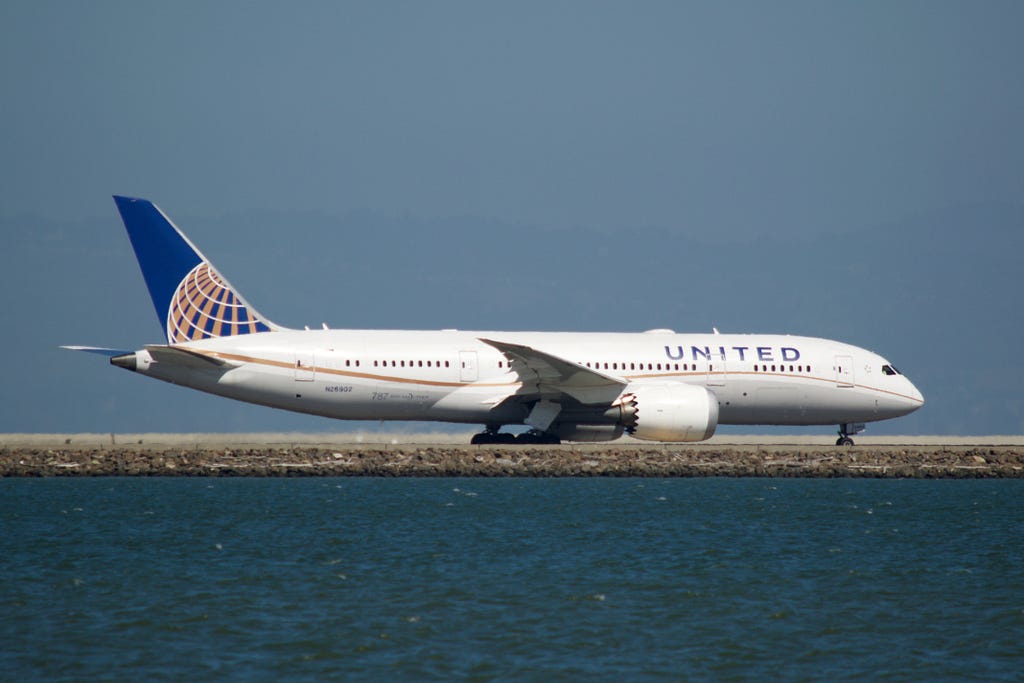 Boeing 787 Dreamliner before takeoff from SFO (September 2016)
Boeing 787 Dreamliner before takeoff from SFO (September 2016)
According to the World Bank, 3.69 billion passengers were transported by airplanes in 2016 — a tenfold increase from 1970.
In 2016, the top 3 countries for air travel by passenger count were: the U.S. (823 million), China (488 million), and the U.K. (148 million).
Currently there are five major manufacturers of civilian aircraft: Airbus (Europe), Boeing (U.S.), Bombardier (Canada), Embraer (Brazil), United Aircraft Corporation (Russia). But the landscape for aircraft manufacturers is changing:
- October 2017: Airbus announced a partnership with Bombardier
- December 2017: reports surface that Boeing wants to acquire Embraer
Technology advances give birth to new industries. As these nascient industries expand, businesses emerge to service the growing addressable market. Over time, the best competitors achieve market dominance and the industry consolidates. This happened to aircraft manufacturing in 2017.
“The cloud-capp’d towers, the gorgeous palaces,The solemn temples, the great globe itself.”
With the rise of new technology and industries, the physical landscape of San Francisco has also changed: it is literally rising.
For decades, the San Francisco skyline was defined by the iconic Transamerica Pyramid. The building was commissioned to be the headquarters for the eponymous holding company of life insurance and investment firms. Construction began in 1969 and was completed in 1972.
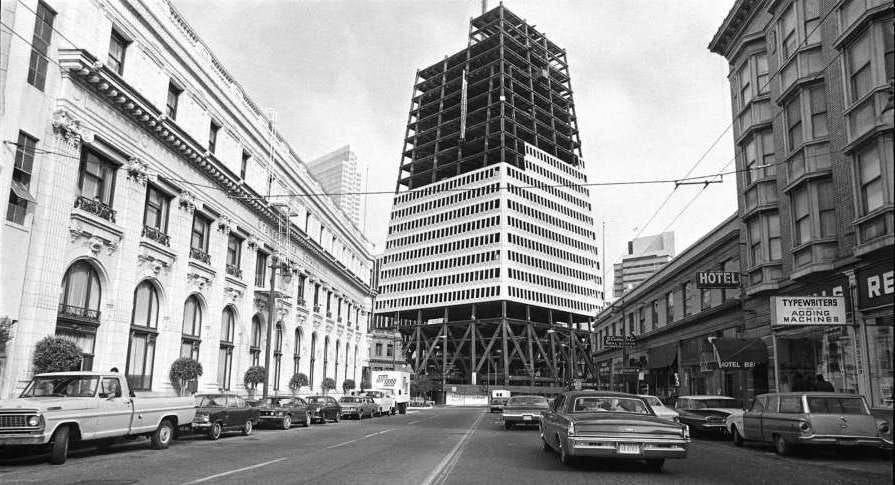 Construction of the Transamerica Pyramid (1969)
Construction of the Transamerica Pyramid (1969)
The Transamerica Pyramid stands at 853 feet (260m). Upon its completion in 1972, it was the eighth tallest building in the world. It has been the tallest building in San Francisco since its construction in 1972.
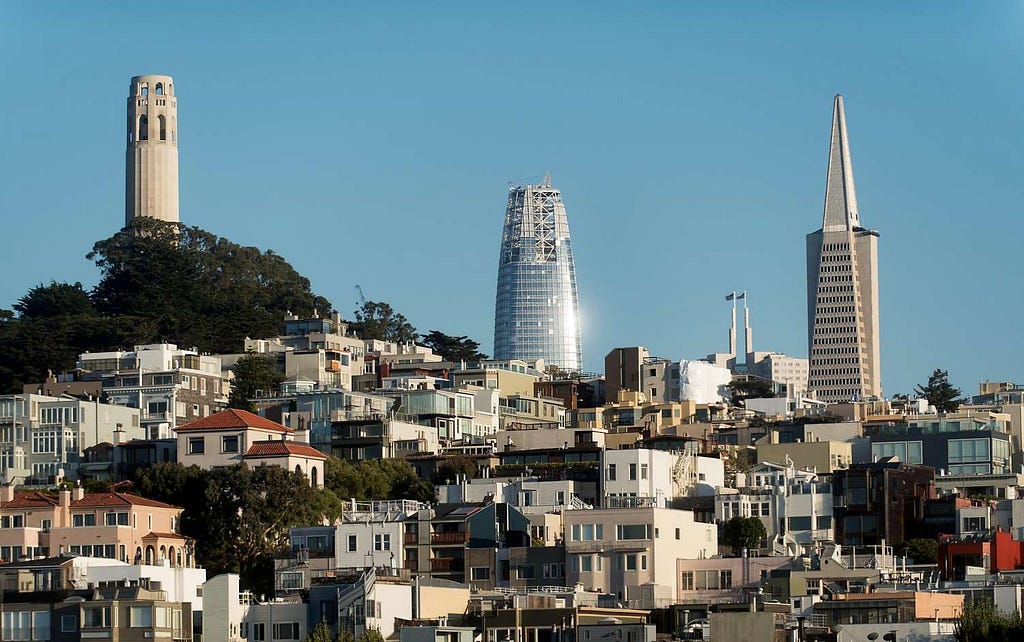 Salesforce Tower rising between two SF landmarks (2017)
Salesforce Tower rising between two SF landmarks (2017)
But as of 2017, the Transamerica Pyramid is the second tallest building in the city. It’s a changing of the guard as the new Salesforce Tower asserts its position in the San Francisco landscape.
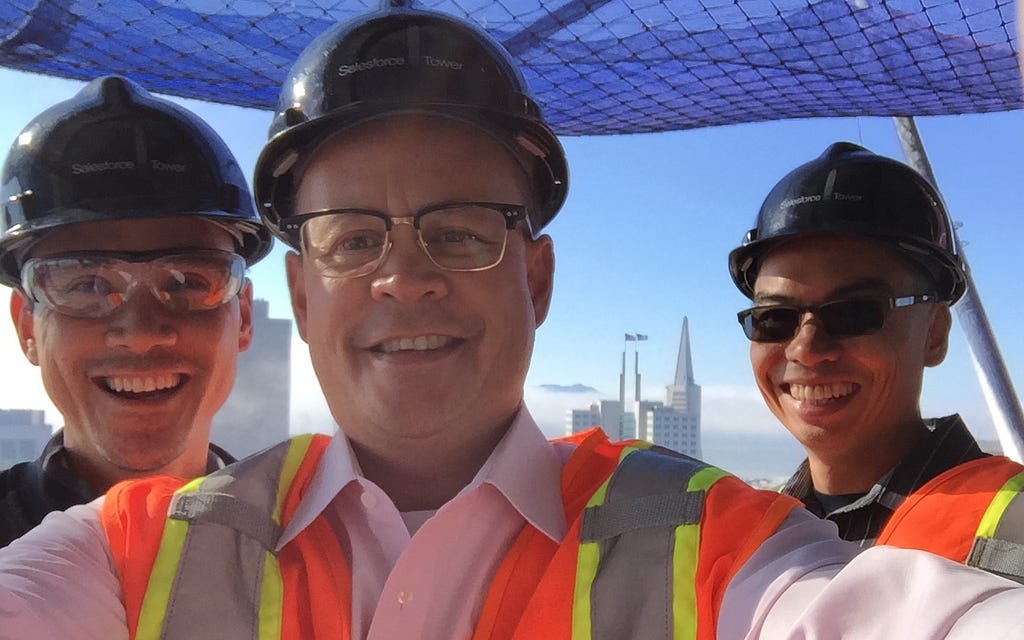 My tour of Salesforce Tower under construction (September 2016)
My tour of Salesforce Tower under construction (September 2016)
Salesforce Tower (formerly known as the Transbay Tower) surpassed the Transamerica Pyramid as the tallest skyscraper in San Francisco. Its roof height is 970 feet (296m), and will have an overall height of 1,070 feet (326m)
The rise of Salesforce Tower heralds the dominance of the technology industry in the city. According to a research report from real estate firm CRBE, there are over 79,000 high-tech jobs in San Francisco. A nearby tower — also under construction — will house thousands of Facebook employees.
Other tech companies with headquarters in San Francisco include: Airbnb, Affirm, Anaplan, AppDirect, Coinbase, Credit Karma, Docker, DocuSign, Dropbox, Eero, Eventbrite, Fastly, Fitbit, Flexport, Github, Instacart, Intercom, LendingHome, LendUp, Lyft, Medium, Mulesoft, Niantic, Nextdoor, Okta, Opendoor, Optimizely, Patreon, Pinterest, Postmates, Reddit, Ripple, Slack, Splunk, StitchFix, Square, Stripe, Thumbtack, Twitter, Uber, Unity Technologies, Yelp, Zendesk.
There are literally hundreds of other tech startups headquartered in the city.
It’s an evolution of San Francisco, consistent with its past: a destination for those seeking opportunity. But this time the gold rush is digital.
“Now I will believeThat there are unicorns”—The Tempest, William Shakespeare
The Past is Prologue was originally published in Hacker Noon on Medium, where people are continuing the conversation by highlighting and responding to this story.
Disclaimer
The views and opinions expressed in this article are solely those of the authors and do not reflect the views of Bitcoin Insider. Every investment and trading move involves risk - this is especially true for cryptocurrencies given their volatility. We strongly advise our readers to conduct their own research when making a decision.